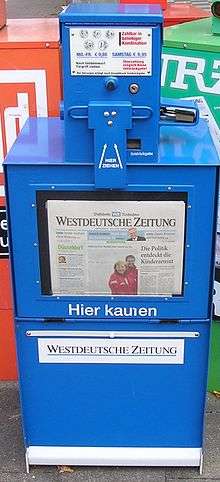Newspaper vending machine

A newspaper vending machine or newspaper rack is a vending machine designed to distribute newspapers. Newspaper vending machines are used worldwide,especially in Germany and they are often one of the main distribution methods for newspaper publishers.
History
The coin operated newspaper vending machine was invented in 1947 by inventor George Thiemeyer Hemmeter.[1][2][3] Hemmeter's company, the Serven Vendor Company, was based in Berkeley, California, and had been making rural mail tubes and honor racks. The new invention could be adjusted to accept coins of different denominations (depending on the cost of the paper sold). The newspaper rack was able to be used with one hand, and took around 30 seconds to dispense a paper. Two models, one with a capacity for 1250 pages of newsprint, the other 2500 pages, were brought into production initially.[4] By 1987, over one million machines had been distributed.[5]

Legal issues
In the United States, publishers have said that the distribution of newspapers by means of street racks is "an essential method of conveying information to the public" and that regulations regarding their placement are an infringement of the First Amendment to the United States Constitution.[6]
In 1983, the city of Lakewood, Ohio adopted an ordinance that gave the mayor of the city complete control of where newspaper racks could be placed, and which newspapers could be placed in them. On June 17, 1988, this ordinance was overturned by the United States Supreme Court in a 4-3 ruling, citing that the ordinance could potentially be used to penalize newspapers that criticize the local government.[7][8][9][10][11]
Re-purposing
The newspaper vending machines began to lose popularity as many newspapers switched to online distribution, and as newspaper prices rose; as most vending machines are completely mechanical with no moving parts, few of them have paper currency validators which need some kind of electrical power to work, requiring multiple quarters or dollar coins to be inserted. This is especially true for Sunday newspapers (for example, the Sunday New York Times costing $6 nationally and requiring 24 quarters in a vending machine), which see machines go unfilled by some papers due to the bulk of those editions reducing the amount of copies that can possibly be sold. By 2009, various artists and inventors had begun working on re-purposing the boxes.[12][13][14]
Criticism
Newspaper vending machines have been criticized for occasionally failing to distribute a newspaper after it has been paid for.[15][16] The newspaper vending machines has also been criticized due to an issue in the design, making it possible for money or newspapers to be stolen from the machine. [17][18] Newspaper machines are frequently cited by economists when discussing "utility value." Due to their design, one could insert the requisite amount and remove more than one copy of the newspaper. However, a second copy of a newspaper represents little value to the thief, as the information contained within the copies is identical. Thus, the potential lost revenue due to stolen copies is mitigated by the low value that the average person places on a second copy of a newspaper. This is obviously problematic when the copy of the newspaper in question could have potential future value, such as on the day after an election, sports event, or major world occurrence.
See also
References
- ↑ "Inventor Dies at 97". Gadsden Times. April 12, 2000. Retrieved October 1, 2011.
- ↑ "Elsewhere". Miami Herald. April 13, 2000. Retrieved October 1, 2011.
- ↑ "George T. Hemmeter; Inventor of Newspaper Racks". April 13, 2000. Los Angeles Times. Retrieved October 1, 2011.
- ↑ "Newspaper Vendor Slated Soon". The Billboard: 75. December 22, 1945.
- ↑ Freitag, Michael (March 22, 1987). "What's New in Newspaper Delivery; After 30 Years, the Coins Keep Jingling". The New York Times. Retrieved October 1, 2011.
- ↑ First Amendment Scholar (2012-02-16). "David L. Hudson Jr., First Amendment Center, February 16, 2012". Firstamendmentcenter.org. Retrieved 2014-04-26.
- ↑ Kilpatrick, James J. (June 23, 1988). "The Press Wins a Misunderstood Victory". The Mount Airy News. Retrieved October 1, 2011.
- ↑ Taylor, Stuart (June 18, 1988). "Supreme Court Roundup; Law That Allowed a Mayor to Rule on Newspaper Racks Is Overturned". The New York Times. Retrieved October 1, 2011.
- ↑ Kamen, Al (June 18, 1988). "Court Limits Cities' Control of News Rack Placement". The Washington Post. Retrieved October 1, 2011.
- ↑ "Justices Rule that News Racks are Protected". Miami Herald. June 18, 1988. Retrieved October 1, 2011.
- ↑ "Court limits power over placement of paper racks". The Palm Beach Post. June 18, 1988. Retrieved October 1, 2011.
- ↑ Vestel, Leora Broydo (June 1, 2009). "Second Lives for Newspaper Dispensers?". The New York Times. Retrieved October 1, 2011.
- ↑ Walker, Scott. "The digital newsstand". June 19, 2007. designondeadline.com. Retrieved October 1, 2011.
- ↑ Carlson, Nicholas (March 19, 2009). "Photos Of Abandoned Newspaper Racks Tell The Industry's Story". Business Insider. Retrieved October 1, 2011.
- ↑ Modzelewski, Joe (January 16, 1980). "Loser's Corner". The Miami News. Retrieved October 1, 2011.
- ↑ "Newspaper vending machine". PatentStorm. Retrieved November 17, 2011.
- ↑ Yousef Haik; Tamer Shahin (May 7, 2010). Engineering Design Process. Cengage Learning. p. 278. ISBN 978-0-495-66814-5. Retrieved February 28, 2012.
- ↑ Hurley, Patrick J. (January 1, 2011). A Concise Introduction to Logic. Cengage Learning. p. 539. ISBN 978-0-8400-3417-5. Retrieved February 28, 2012.